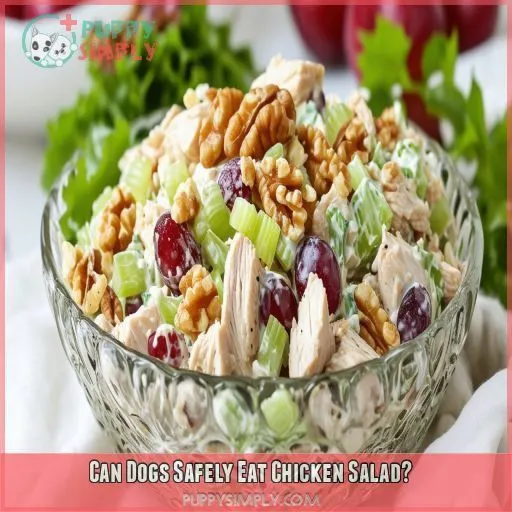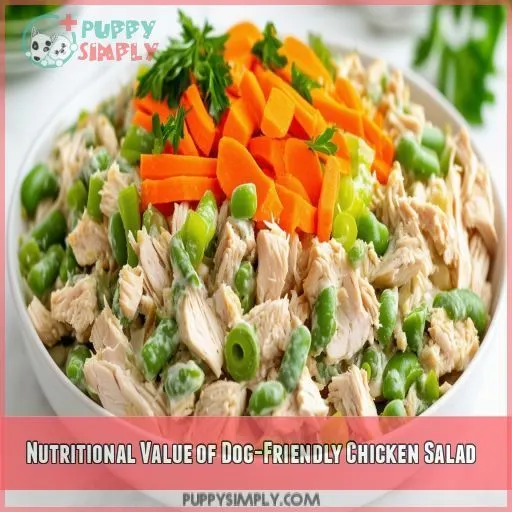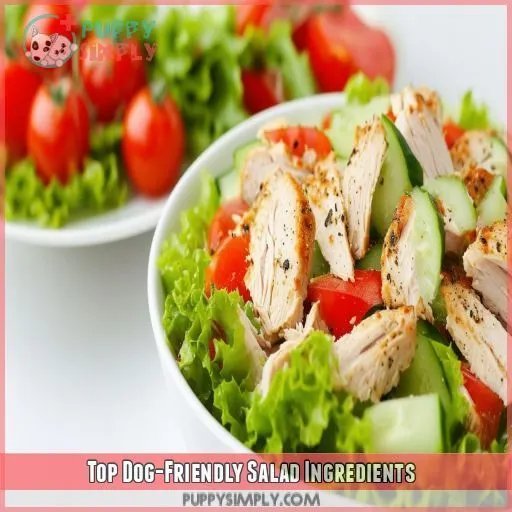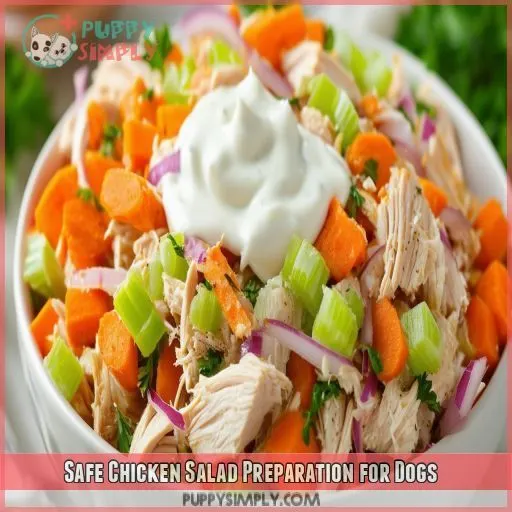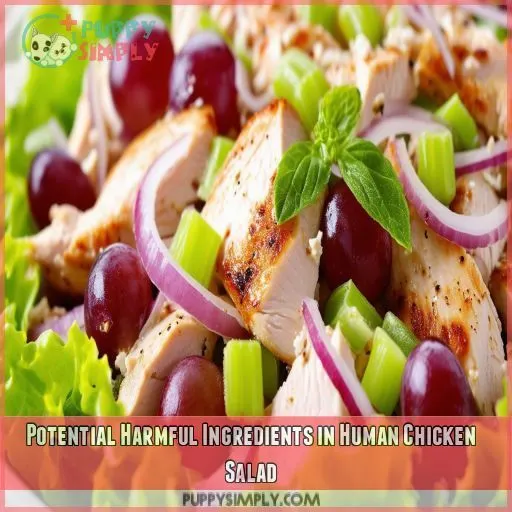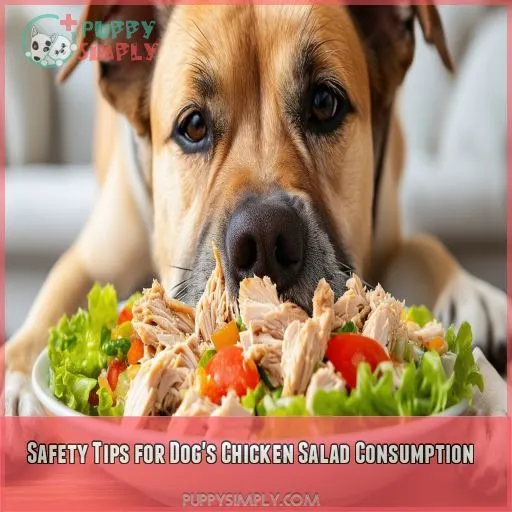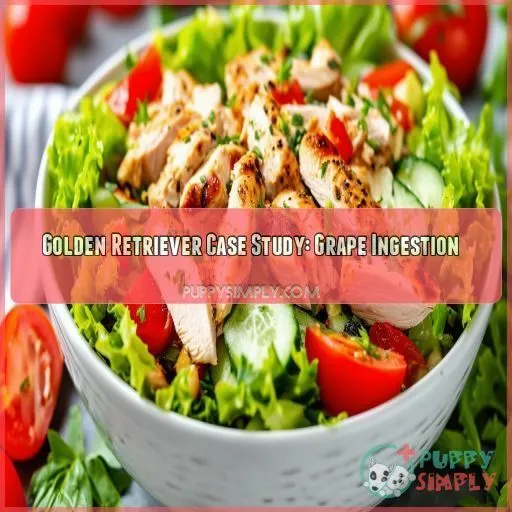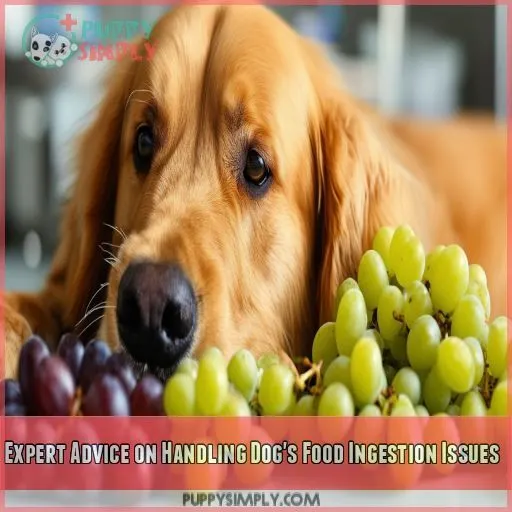This site is supported by our readers. We may earn a commission, at no cost to you, if you purchase through links.
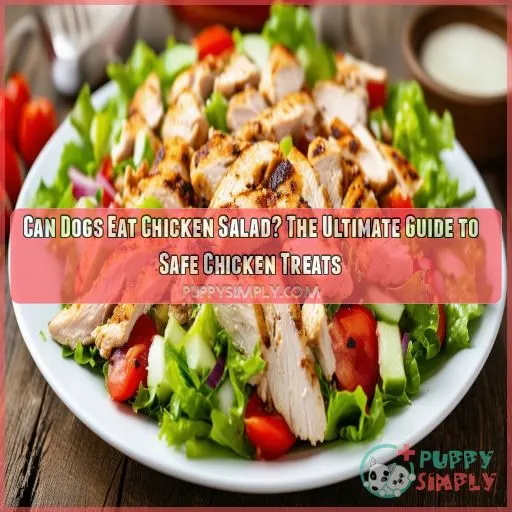 Yes, dogs can eat Chicken salad – but with major caveats. Traditional recipes contain ingredients toxic to dogs like onions, grapes, and nuts.
Yes, dogs can eat Chicken salad – but with major caveats. Traditional recipes contain ingredients toxic to dogs like onions, grapes, and nuts.
Instead, make a dog-friendly version using cooked chicken, plain yogurt, and veggies like carrots and peas. This provides essential protein for energy and growth while avoiding hazards.
Properly prepared, chicken salad can be a nutritious addition to your pup’s diet. But be vigilant about ingredients – grapes and raisins, for example, can cause kidney failure in dogs.
Follow safe preparation tips to offer this tasty, healthy treat guilt-free. And stay tuned for an expert deep-dive into potential issues.
Table Of Contents
- Key Takeaways
- Can Dogs Eat Chicken Salad?
- Can Dogs Safely Eat Chicken Salad?
- Nutritional Value of Dog-Friendly Chicken Salad
- Top Dog-Friendly Salad Ingredients
- Safe Chicken Salad Preparation for Dogs
- Potential Harmful Ingredients in Human Chicken Salad
- Understanding Toxicity of Grapes, Nuts, Onions & Garlic to Dogs
- Safety Tips for Dog’s Chicken Salad Consumption
- Golden Retriever Case Study: Grape Ingestion
- Expert Advice on Handling Dog’s Food Ingestion Issues
- Frequently Asked Questions (FAQs)
- Can dogs eat chicken and mayonnaise?
- Can dogs eat plain chicken salad?
- What salad can dogs not eat?
- Can dogs eat chicken sandwiches?
- How often can dogs eat chicken salad?
- What is the ideal portion size for dogs?
- Can chicken salad be frozen for later use?
- How long does homemade chicken salad last for dogs?
- Can dogs eat chicken salad every day?
- Conclusion
Key Takeaways
- Who knew making chicken salad for Fido could be such a minefield? It’s like walking a tightrope: one false move with the wrong ingredients, and your furry friend could be facing some serious consequences!
- The key to a wagging-tail-approved chicken salad? Ditch the toxic stuff like onions, grapes, and nuts – they’re a big no-no for our canine companions. Instead, whip up a tasty treat using cooked chicken, plain yogurt, and veggies like carrots and peas. Yum!
- Portion control is crucial when it comes to doggy delicacies. A couple of tablespoons for the little guys, and up to a half cup for the big pups. Any more, and you might have a pudgy pooch on your hands!
- At the end of the day, you know your dog best. If they start exhibiting any strange symptoms after chowing down on that homemade chicken salad, it’s time to call in the vet cavalry. Better safe than sorry when it comes to our beloved fur babies!
Can Dogs Eat Chicken Salad?
No, dogs shouldn’t eat chicken salad. While cooked chicken is safe for dogs in moderation, chicken salad often contains ingredients like mayonnaise, grapes, onions, and garlic that can be harmful or even toxic to dogs (Source).
Can Dogs Safely Eat Chicken Salad?
While chicken salad can be a tasty treat for humans, it’s not always the best choice for our canine companions.
Traditional chicken salad often contains ingredients that are unsafe or even toxic for dogs, such as onions, grapes, and certain nuts.
However, with a few simple tweaks, you can create a delicious and dog-friendly chicken salad that your furry friend will love.
By using cooked chicken, plain yogurt, and dog-safe veggies like carrots and peas, you can whip up a healthy homemade treat that’s perfect for portion-controlled snacking.
Just be sure to avoid any questionable ingredients and always consult with your veterinarian for personalized advice on your dog’s dietary needs.
Nutritional Value of Dog-Friendly Chicken Salad
Dog-friendly chicken salad provides essential protein for muscle growth, boosts energy, and supports overall well-being in dogs.
The protein content is fundamental for maintaining healthy bones and promoting muscle growth.
This nutrient-dense salad is a valuable addition to a dog’s diet, guaranteeing they receive the necessary nutritional support for their active lifestyle.
When prepared according to the dog-friendly chicken salad recipe, which excludes harmful ingredients such as mayonnaise and includes safe components like parsley and cooked chicken, it becomes a beneficial and enjoyable treat for your furry friend.
The portion sizes specified in the recipe guidelines also guarantee that the salad isn’t excessive, maintaining a healthy balance in the dog’s daily food intake.
Top Dog-Friendly Salad Ingredients
When creating a dog-friendly chicken salad, you should incorporate cooked chicken (boneless and skinless), chopped carrots for fiber and nutrients, cooked peas for added vitamins, plain Greek yogurt for a creamy texture, and parsley for a hint of freshness—these ingredients provide balanced nutrition while avoiding potential hazards like fatty mayonnaise or toxic seasonings.
Cooked Chicken
Cooked chicken is a safe and nutritious ingredient for your dog’s chicken salad.
Thoroughly cook boneless, skinless chicken breasts until no longer pink inside, about 30 minutes at 400°F.
Shred the cooked chicken into bite-sized pieces.
Portion sizes should be small, 2-3 tablespoons for small dogs and up to 1/2 cup for larger breeds.
Cooked chicken can be refrigerated for up to 5 days or frozen for longer storage.
Chopped Carrots and Peas
Carrots and peas are excellent additions to your dog’s chicken salad, providing fiber, vitamins, and minerals. Chopped carrots add a satisfying crunch, while cooked peas offer a pop of color and nutrients. Combine these veggies with shredded chicken for a balanced, wholesome treat your furry friend will love. Celery is another crunchy option to explore.
Plain Greek Yogurt
Plain Greek yogurt is a fantastic addition to your dog’s chicken salad. It provides protein, calcium, and probiotics to support their overall health. However, be cautious with portion sizes, as too much can cause digestive upset. Avoid flavored yogurts high in sugar. Always consult with your veterinarian before making significant changes to your dog’s diet.
| Nutrient | Amount per 100g |
|---|---|
| Protein | 10g |
| Calcium | 120mg |
| Probiotics | Live Cultures |
Parsley (Optional)
Parsley, often used as a flavoring, can also be beneficial for dogs in moderation.
While it can contribute to freshening breath, providing antioxidants, and supporting digestion, always use it with caution.
When making chicken salad for dogs, consider using parsley sparingly due to its potential benefits.
Additionally, plain Greek yogurt, a safer alternative, can bring creaminess to the recipe without any potential risks.
Remember to monitor for symptoms like vomiting, lethargy, and pale gums (Source).
Safe Chicken Salad Preparation for Dogs
To safely prepare chicken salad for your canine companion, start by thoroughly cooking boneless, skinless chicken breasts until no longer pink. Shred the cooked chicken into bite-sized pieces and set aside. Boil carrots and peas until tender, then drain and allow to cool. In a large bowl, mix the shredded chicken, cooked veggies, and plain Greek yogurt. Portion sizes vary based on your dog’s size: small dogs get 2 tablespoons, while medium to large dogs can enjoy up to 1/2 cup. For extra flavor, stir in some fresh parsley. Store leftovers in an airtight container in the fridge for up to 5 days or freeze for longer-term storage. Always consult your vet before introducing new foods to your dog’s diet.
| Ingredient | Portion Size | Substitutions |
|---|---|---|
| Chicken | 1 lb boneless, skinless breasts | Ground turkey or beef |
| Carrots | 1 cup shredded | Sweet potatoes |
| Peas | 1 cup cooked | Green beans |
| Yogurt | 3/4 cup plain Greek | Cottage cheese |
| Parsley | 1/4 cup chopped | Cilantro |
Potential Harmful Ingredients in Human Chicken Salad
When considering the potential harmful ingredients in human chicken salad for dogs, it’s essential to be aware of toxic components such as mayonnaise, grapes, nuts, onions, and garlic .
Mayonnaise isn’t dog-friendly due to its high fat content, which can lead to weight gain and health issues. Instead, consider using plain yogurt in small amounts for creaminess .
In the case of toxic ingredients, grapes can be extremely harmful to dogs, with as few as 10-12 grapes being toxic for a 20-pound dog .
Additionally, certain nuts, onions, and garlic can also be toxic to dogs, causing adverse effects such as damage to red blood cells and potential kidney failure .
Understanding the potential harm these ingredients pose is paramount to ensuring the safety of your dog.
Understanding Toxicity of Grapes, Nuts, Onions & Garlic to Dogs
Grapes, nuts, onions, and garlic are toxic to dogs and should never be included in their chicken salad.
Grapes can cause kidney failure in dogs, even in small amounts.
Certain nuts like walnuts and macadamia nuts are also toxic, potentially leading to vomiting, lethargy, and abdominal pain.
Onions and garlic contain substances that damage red blood cells, causing anemia.
If your dog accidentally ingests any of these ingredients, monitor them closely for symptoms like vomiting, diarrhea, and lethargy.
In severe cases, hydrogen peroxide may be used to induce vomiting under veterinary guidance.
Consult your vet immediately if you have concerns about your dog’s safety.
Safety Tips for Dog’s Chicken Salad Consumption
Now that you know the key ingredients to avoid when making chicken salad for your pup, it’s time to discuss some important safety tips.
First and foremost, always consult with your veterinarian before introducing any new foods, especially if your dog has allergies or dietary restrictions (Source).
Portion sizes are essential – a good rule of thumb is 2 tablespoons for small dogs and up to 1/2 cup for medium to large breeds .
Be mindful of your dog’s calorie intake and adjust their regular meals accordingly to prevent weight gain .
If you’re unsure about a specific ingredient or have concerns, it’s best to err on the side of caution and stick to commercial dog foods formulated by animal nutrition experts.
Golden Retriever Case Study: Grape Ingestion
In a case study, a 55-pound Golden Retriever ingested 5-10 grapes, a potentially toxic amount for dogs. Grapes can lead to kidney failure in severe cases, with a toxic dose ranging from 10-12 grapes for a 20-pound dog. Symptoms to watch for include vomiting, diarrhea, lethargy, and abdominal pain. Fortunately, this Golden Retriever vomited twice after being given hydrogen peroxide, a common method to induce vomiting in dogs who’ve ingested toxic substances. The dog isn’t expected to experience any adverse effects, as the grapes were below the published toxic level for a dog of this weight. However, it’s imperative to monitor your dog’s condition and consult a veterinarian if any concerning symptoms arise.
| Symptom | Severity |
|---|---|
| Vomiting | Mild |
| Diarrhea | Moderate |
| Lethargy | Severe |
| Abdominal Pain | Severe |
Expert Advice on Handling Dog’s Food Ingestion Issues
As an expert, I recommend closely monitoring your dog’s health and being prepared for emergencies if they accidentally ingest human food. Identify potential hazards like grapes, nuts, onions, and garlic that can be toxic to dogs. Avoid cross-contamination by keeping human and pet food preparation areas separate. Store food safely to prevent access. If your dog eats something concerning, contact your vet immediately. Symptoms like vomiting, diarrhea, lethargy, and pale gums warrant urgent attention. With proper precautions and quick action, you can keep your furry friend safe and healthy. Remember, an ounce of prevention is worth a pound of cure for your beloved pet’s well-being.
- Identify potential hazards
- Avoid cross-contamination
- Store food safely
- Monitor pet’s health
- Be prepared for emergencies
Frequently Asked Questions (FAQs)
Can dogs eat chicken and mayonnaise?
No, you should avoid giving dogs chicken salad with mayonnaise. Mayonnaise is high in fat, which can cause pancreatitis and weight gain in dogs. Instead, try making a dog-friendly chicken salad with plain yogurt and dog-safe veggies.
Can dogs eat plain chicken salad?
Plain chicken salad is generally safe for dogs, provided it contains no toxic ingredients like onions, garlic, or grapes. For best safety, make a dog-friendly version using cooked chicken, veggies like carrots and peas, and plain yogurt instead of mayo.
What salad can dogs not eat?
Salads with grapes, onions, nuts, or excessive fat are off-limits. You wouldn’t want Fido exposed to anything toxic or unhealthy. Stick to wholesome ingredients like cooked chicken, veggies, and a dollop of plain yogurt for a pup-approved salad.
Can dogs eat chicken sandwiches?
You should avoid giving dogs chicken sandwiches. The bread, mayo, and other toppings could upset their stomachs or cause health issues. Stick to plain, cooked chicken as a safer treat.
How often can dogs eat chicken salad?
Let’s look at your 60-pound Labrador. You could safely give her a scoop (1/4 cup) of dog-friendly chicken salad once or twice weekly as a healthy treat.
What is the ideal portion size for dogs?
The ideal portion size depends on your dog’s size: small dogs around 2 tbsp, medium dogs 1/4 cup, large dogs 1/2 cup. Monitor for any digestive issues and adjust as needed.
Can chicken salad be frozen for later use?
Like a tasty time capsule, freezing chicken salad preserves its freshness for future doggy delights. Just prepare in batches, portion into treats, and freeze for grab-and-go convenience when your pup’s tail calls.
How long does homemade chicken salad last for dogs?
Homemade chicken salad lasts 3-4 days refrigerated. For longer storage, freeze portions; they’ll keep 2-3 months. Discard any salad left at room temperature over 2 hours.
Can dogs eat chicken salad every day?
While it’s okay for dogs to have chicken salad occasionally, feeding it daily isn’t recommended. Over 20% of pet obesity cases stem from excessive treats and table scraps. Chicken salad is high in fat and calories, which can lead to weight gain and other health issues in dogs.
Conclusion
Satirically, we’ve transformed a simple chicken salad into a gastronomic minefield for our beloved canines.
But in all seriousness, with vigilance over ingredients like grapes, onions, and nuts, you can safely offer your pup the nutritional benefits of a dog-friendly chicken salad.

